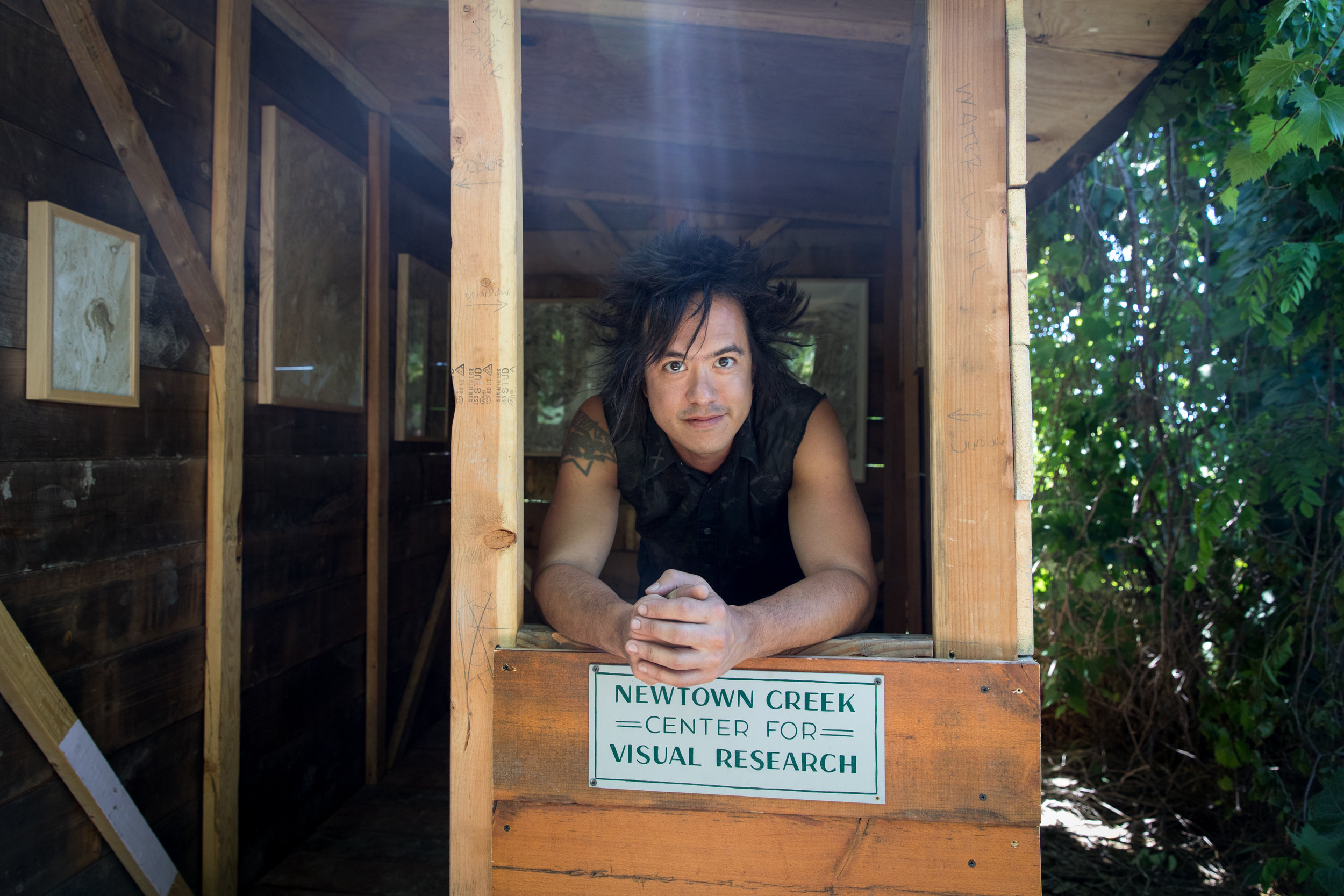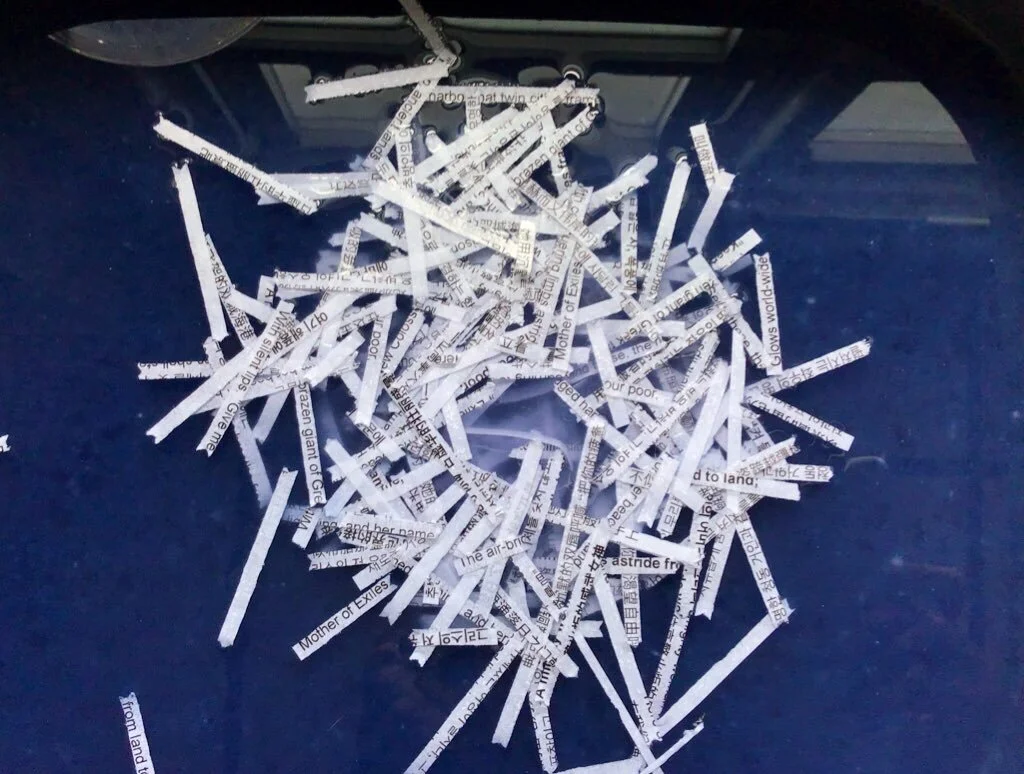Daylighting the Stream is an immersive, hypnagogic exploration of the subconscious mind, buoyed by scientific and documentary material. We draw parallels between bodies of water and our bodies made-of-water, and the interplay between the conscious, subconscious and dreaming minds. Participants will believe they are dreaming.
Daylighting the Stream draws inspiration from the subterranean rivers of New York and Pittsburgh. “Daylighting” describes an infrastructure project that re-exposes natural waterways that had been covered for urban development. Following successful daylightings of Seoul’s Cheonggyecheon and the Sawmill River in downtown Yonkers, NY, a daylighting of the Panther Hollow waterway in Pittsburgh is underway. The immersive encounters are intensely personal, and give participants layers of agency that encourage them to confront their roles in the past, present and future of human interactions with water and waterways. Urban development has buried the constant movement of water under our feet, but these streams from the past still exist, waiting to be rediscovered. Daylighting these streams exposes humanity’s past interactions with water, and provides a map to our future relationship with this most important natural resource.
Alex Branch
Melissa F. Clarke
Melissa F. Clarke is a Brooklyn based interdisciplinary artist whose work employs data and generative self-programmed compositional environments. She creates multimedia installations, generative video and sound sculptures, performances, and printed images. Her work often explores bathymetry data that describes the landscapes beneath glacier carved waterways, including the Hudson River and seas around Antarctica and Greenland. For her residency with Works on Water and Underwater New York, Clarke will be looking towards the confluence of the Hudson and East Rivers, where the Upper NY Bay begins, and revisit her process of using Bathymetric Data to create a time based experiential installation.
Sarah Nicholls
Sarah Nicholls is an artist, printmaker, and writer whose work combines language, image, visual narrative, and time. She publishes an ongoing series of letterpress pamphlets on climate change, urban ecology, and the history of science and technology, and organizes a range of walks and programs around the series. Her work has received support from the Lower Manhattan Cultural Council, the Brooklyn Arts Council and the Puffin Foundation, and she has taught letterpress and book arts at Pratt Institute, Parsons School of Design, and University of the Arts in Philadelphia.
Nicki Pombier
Nicki Pombier is an oral historian, writer and educator, and founding editor of Underwater New York. Her work in oral history engages the arts, disability justice and social change, with a particular focus on how to be a narrative ally, collaborating across ability. She is passionate about teaching and learning, and works with undergraduates at the College of Performing Arts at The New School and graduate students in the Oral History Master of Arts Program at Columbia University.
In all that Nicki does, she strives to work oral historically—deeply invested in co-creation, grounded in listening, with a rigorous ethic around stewarding stories into the world, in the labor of belief that doing this work might create better conditions for justice, repair, restoration, and restitution.
More about Nicki’s work can be found at www.nickipombier.com
Susannah Ray
The intersection of city and water is at the heart of Susannah Ray’s photography and extends her early interest in landscape photography, which she uses as a form of visual geography, rendering the complex interrelationships of place, people, history, and ideology. During her June residency in the Project Space, Susannah Ray showed large scale photographs from her series “Down For the Day,” a long-term look at urban beach use in Rockaway Beach, Queens. Her previous project, “A Further Shore,” was exhibited at The Bronx Museum of the Arts in 2017-2018 and was published in 2017 by Hoxton Mini Press, East London, UK as New York Waterways. Susannah Ray has also had solo exhibitions at Bonni Benrubi Gallery and Albright College and been in numerous group exhibitions, notably at The Museum of the City of New York and The Queens Museum. Her photographs have been widely featured and reviewed in publications including: The New York Times, The New Yorker, The British Journal of Photography, The Surfer’s Journal, The Independent UK, and The Wall Street Journal
/Rive
Samara Smith, Ashok Basawapatna, Laura Chipley
Edmund Mooney
Magali Duzant
Asya Graf
Supriya Wheat
Supriya Wheat is a writer and educator who has been involved in the field of education for ten + years. She was a 2007 Teach for America Corps Member, a New York Hall of Science Design Fellow & Master Teacher, a New York Public Library Cullman Fellow in Creative Writing, and currently teaches a life science course at the School at Columbia University. In 2017, Fund for Teachers awarded her a grant to document youth-led initiatives to curb climate change in the island nations of the Maldives and Zanzibar. Her more recent work centers around exploring human interactions with the environment. Lately, she finds herself preoccupied with how bodies of water in and around New York City might serve both as a medium for change and constancy.
Jean Carla Rodea
Jean Carla Rodea is an interdisciplinary artist and educator from Mexico City and currently based in Brooklyn, NY. Her work involves a variety of disciplines and mediums such as music, sound, performance, movement, photography, video, and sculpture.
Her artistic practice deals with spaces and instances where socio-political and cultural constructs are rendered visible through multi-media installations and performance.
Rodea is invested in understanding how time is insistently constructed through memory and how these memories whether embodied or recorded in spaces are documented and re/constructed. Archival research – whether it takes place in an institution or her personal archive – often leads her to draw from fiction and speculative history around documents, physical traces, and spaces. Rodea has performed extensively and shown work at Roulette, Carnegie Hall, BRIC, Knockdown Center, Judson Church, Danspace, Center for Performance Research, Panoply Lab, Rio ll Gallery, The Clemente, El Museo de Los Sures, to mention a few.
David Andree
Mary Giamo
Nate Dorr
Presented in the Project Space in 2019,
Shoreline Change: New Films by Nathan Kensinger & Nate Dorr
Shoreline Change is a collection of recent films created by Nathan Kensinger and Nate Dorr, who have been collaboratively documenting the waterfront of New York City for the past 13 years. These works investigate the rapidly changing coastline of the city, where frequently flooded neighborhoods are now being demolished to make way for either new wetlands or new residential towers. As New York City contemplates how to best address the existential threat of sea level rise, these works excavate its complicated history of polluted landfills and degraded wetlands, while considering visions of a multi-species future shaped by water.
Nathan Kensinger
Presented in the Project Space in 2019,
Shoreline Change: New Films by Nathan Kensinger & Nate Dorr
Shoreline Change is a collection of recent films created by Nathan Kensinger and Nate Dorr, who have been collaboratively documenting the waterfront of New York City for the past 13 years. These works investigate the rapidly changing coastline of the city, where frequently flooded neighborhoods are now being demolished to make way for either new wetlands or new residential towers. As New York City contemplates how to best address the existential threat of sea level rise, these works excavate its complicated history of polluted landfills and degraded wetlands, while considering visions of a multi-species future shaped by water.
Meredith Drum
For her 2019 residency, Meredith Drum will be working on People of the Desert 122° F
A meditation on the past and future of this city: here the Ancestral Sonoran Desert People constructed the largest Pre-Columbia irrigation system in North America, history obliterated by the colonial construction that became contemporary Phoenix. Now over 150 people die each summer from heat-related trauma, and with a record high of 122° F what happens at 129° - adaptation or abandonment?
Clarinda Mac Low
Clarinda Mac Low began in dance and molecular biology and now creates participatory events investigating social constructs and corporeal experience. She is Executive of Culture Push, an organization linking artistic practice and civic engagement, and one of the co-founders and core team members of Works on Water. Mac Low’s recent work includes: “Sunk Shore,” a speculative tour of the future; “Incredible Witness,” game-based investigation of the sensory origins of empathy; “Free the Orphans,” spiritual and intellectual implications of intellectual property in a digital age; and "Cyborg Nation," public conversation on the technological body and intimacy. Residencies include MacDowell, Yaddo, and Mount Tremper Arts. Grants/Honors: BAX Award, Foundation for Contemporary Arts grant and Franklin Furnace grant. She has received BA Dance and Molecular Biology (Wesleyan University) and and MFA in Digital Interdisciplinary Arts Practice (CCNY-CUNY).
sTo Len
sTo Len is a genre fluid artist with interests in printmaking, installation, sound, video and performance. The cross-disciplinary nature of Len's work includes ongoing collaborations with bodies of water, transforming public space into art studios, recycling waste into art materials, and hosting performances at Superfund sites. sTo Len is based in Queens, NY with familial roots in Vietnam and Virginia, and his work incorporates these bonds by connecting issues of their history, environment, traditions and politics. As part of WoW, Len created the Newtown Creek Center for Visual Research in Maspeth, Queens, and WoW Radio, a water-themed pirate radio show on Governors Island. www.stoishere.com
Rejin Leys
Rejin Leys is a mixed media artist and paper maker based in New York whose work has been exhibited internationally and is included in several public collections. Her PulpMobile papermaking studio on a cart is an interactive public art project which has been active at community events and public art festivals. Leys is a recipient of a fellowship from the New York Foundation for the Arts. She received a BFA from Parsons School of Design and an MFA from Brooklyn College.












